I’ve wanted to further explore the world of open baffle (OB) loudspeakers for a few years now ever since a friend Paul visited us and brought along a pair of DIY 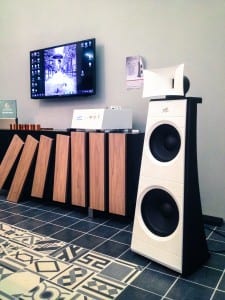 OBs (with a horn on top) for a listen. From what I’d read I was expecting to be disappointed with them from the perspective of bass performance – regular readers will be well aware of my penchant for bass..and good quality bass at that – but I couldn’t have been more wrong and I soon set about collecting the bits and pieces to build a pair…needless to say, like a lot of my DIY projects nothing came of it and so it was with a good deal of excitement that I awaited delivery of the Diesis Auras.
OBs (with a horn on top) for a listen. From what I’d read I was expecting to be disappointed with them from the perspective of bass performance – regular readers will be well aware of my penchant for bass..and good quality bass at that – but I couldn’t have been more wrong and I soon set about collecting the bits and pieces to build a pair…needless to say, like a lot of my DIY projects nothing came of it and so it was with a good deal of excitement that I awaited delivery of the Diesis Auras.
The Diesis Auras are a 2 way plus 1 system that uses three speakers – a 12” paper coned driver and a 10″ paper coned driver in the open baffle and an exponential horn (compression driver) on top which flares to around 16.5 cm across. They stand 114cm high, are 41cm wide at the bottom of the OB, taper to 29cm at the top and have a depth of 30cm. They weigh 47KG each! The Auras are pretty sensitive at 93db and crossover points are at 200 and 1800 Hz with the speakers having nominal impedance of 6 Ohms. In room measurements say they will go down to 42 Hz and up to 23 000Hz plus or minus 3dB.
The baffle itself is made from a resin like material made up of mineral powders (marble), cement and resins which are thrown in a single mould. Crossover parts are high quality military spec’ affairs, as is the cabling. The front panel, which is made of 1” thick fiberglass flares a little around the drivers and is designed so that it can be changed to match your room décor. The woofers are cleverly fixed in place by a proprietary system (Totalfix) so you don’t see any screws on the back of the baffle… or the front. The speakers come with a three year warranty.
They’re a very elegant looking loudspeaker oozing Italian style, their aesthetics will certainly appeal to those looking for a “statement loudspeaker” and without exception everyone who has been to the house whilst they were in place has commented positively on their appearance.
Obviously the Diesis Aura are open at the back and the crossover is clearly visible. The claims of military grade components is beyond argument I’d suggest and likewise the binding posts are of a very high quality. I suppose that with everything being on show there’s really nowhere to hide shoddy components or finish.
Positioning
You can’t just plonk these speakers down and expect to get the best from them. I messed about with positioning a great deal (no mean feat given their weight). I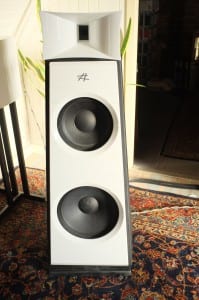 had them out in the room and closer to the back wall, but given the open plan nature of our listening room a “close to back wall” position was difficult to achieve…and indeed not really beneficial. In the end I preferred the sound when they were about a metre out into the room and well away from side walls, with a good bit of toe-in towards the listening position. Yes, absolute bass response did suffer a little, but you also benefit from a more open and expansive feel to the sound.
had them out in the room and closer to the back wall, but given the open plan nature of our listening room a “close to back wall” position was difficult to achieve…and indeed not really beneficial. In the end I preferred the sound when they were about a metre out into the room and well away from side walls, with a good bit of toe-in towards the listening position. Yes, absolute bass response did suffer a little, but you also benefit from a more open and expansive feel to the sound.
Sound
Theses speakers should really not work with lower frequencies as the baffle is just too narrow and at low listening levels you do get the impression that they are a little light in the bass department – quoted response is down to 42 Hz . However, what you miss in absolute “oomph” at low levels is made up by a tightness and tunefulness of bass, with speed and absolutely no flabbiness. Actually, and after only a short period of acclimatization, the quality of the bass these speakers produce is really quite addictive – it’s not plumbing the depths of some speakers, but it is that speed and tightness that I enjoyed… perhaps this is down to the directness of the sound reaching the listener.
Crank the volume up a little and you just get more of the tight bass sound, but on the likes of Deep Purple’s “Smoke on the Water” from Made in Japan I was left wanting a little when the grunty bass guitar kicks in.
Where these speakers really excel to my mind is with acoustic music and Mike Softley’s “The War Goes On” sounds really incredible. The slight “twang” and “liveness” of the acoustic guitar is as good as I’ve heard in the house. Likewise Doug MacLeod’s “Black Night” sounds pretty wonderful with the single blues guitar sounding sparkling and clear. MacLeod’s voice shows restraint and has a plaintive quality coming through, whilst the bass guitar and percussion work well together without any one part being overshadowed by the other – nicely balanced. With female vocals the quality of the mids really shine through and again you get that sense of openness to the sound. This sounds pretty obvious given the lack of boxes but it’s something that you need to hear if you haven’t experienced it. I’d have loved to have heard these speakers with my old 300B amp in PSE configuration – that mid-band quality that you get with the 300B tubes would be a winning combo with the Auras I reckon.
On relatively simple music these speakers really are good when given a little power, in this case provided by the Tellurium Q Iridium that pumps out around 17 W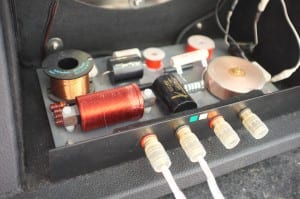 of class A power per channel…I’d have liked a little more power, but more on this later. It may seem an odd one to say these work really well on simple music and then to talk about them sounding good with techno, but some techno (here is was Trésor’s 109 album) is actually very simple music with not a great deal going on. Here the speakers sounded composed and well balanced across the frequencies with just enough bass to satisfy. Again there is crispiness to the upper registers, an openess to the mids and a lovely tight quality to the bass that is hard to define – it seems more immediate (uncoloured?) than with conventional loudspeakers.
of class A power per channel…I’d have liked a little more power, but more on this later. It may seem an odd one to say these work really well on simple music and then to talk about them sounding good with techno, but some techno (here is was Trésor’s 109 album) is actually very simple music with not a great deal going on. Here the speakers sounded composed and well balanced across the frequencies with just enough bass to satisfy. Again there is crispiness to the upper registers, an openess to the mids and a lovely tight quality to the bass that is hard to define – it seems more immediate (uncoloured?) than with conventional loudspeakers.
However, on heavy rock the Auras can become a little shouty and over bearing in the upper frequencies at loud volumes and it is for this reason that Diesis include a choice of crossover components that users can swap out to get the sound they enjoy dependent on the music type and the room conditions. Basically Diesis have developed a system that allows the end user to manually change the resistance and they supply 3 Mundorf resistors 3.3, 5.6 et 8,2. With the 3.3 resistor in place in the crossover they can become a little harsh and over-bearing in the highest frequencies – it’s almost as if there is just too much information coming through. Swap the resistor in the crossover and things become a little less unforgiving and a lot more even handed. It’s a useful feature that allows you to find the sound you are most happy with.
These loudspeakers have a strong point and that is, as mentioned, with simpler music and so it is on with Vladyslav Sendecki at Schloss Elamau (solo piano). This is something else, and the 3.3 resistor is back in place. The detail in the upper registers that was too much on rock music allows the detail of the recording to shine out. The piano sounds like a piano and there is a real insight into the recording space. Mid-band is really beautifully rendered. Likewise with Jerome Sabbagh and his album “The Turn”, you are presented with the musicians in front of you with a good and deep soundstage that projects out nicely into the room too. Hi-hat play is crispy and snare hits are visceral, whilst the over-driven guitar is reproduced excellently.
During the last few days of the review period with the Diesis Aura a pair of Merill Audio Veritas amps came in for review and it seemed only right to give them a 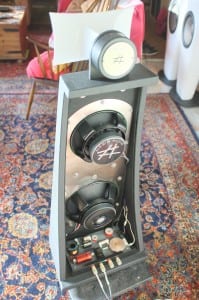 whirl with these speakers. The TQ amp is rated at 17W a channel and whilst it controls everything very nicely I wanted more power. Popping in a Quad 606, whilst offering this power, did little but highlight the inadequacies of the Quad in a high-end environment and I preferred the limited power but control and refinement of the TQ. The Veritas amps use NCore modules and deliver a huge amount of power and the Diesis Aura’s like this a lot! The sound immediately steps up and there is just more oomph to proceedings, with more power to the bass and more slam. Smoke On The Water comes alive when the bass guitar kicks in comparison to how it sounded previously, but it’s certainly not the best loudspeaker i’ve heard with this kind of music. With rock music you still need to add the attenuation in the crossover otherwise the sound becomes shrill, unbalanced and fatiguing.
whirl with these speakers. The TQ amp is rated at 17W a channel and whilst it controls everything very nicely I wanted more power. Popping in a Quad 606, whilst offering this power, did little but highlight the inadequacies of the Quad in a high-end environment and I preferred the limited power but control and refinement of the TQ. The Veritas amps use NCore modules and deliver a huge amount of power and the Diesis Aura’s like this a lot! The sound immediately steps up and there is just more oomph to proceedings, with more power to the bass and more slam. Smoke On The Water comes alive when the bass guitar kicks in comparison to how it sounded previously, but it’s certainly not the best loudspeaker i’ve heard with this kind of music. With rock music you still need to add the attenuation in the crossover otherwise the sound becomes shrill, unbalanced and fatiguing.
Conclusion
These are a fine loudspeaker with regards build quality, finish and sound quality. You are obviously paying a premium for the level of finish here, but this is high-end audio and fit and finish matter, but this will affect the attractiveness on a sound per pound basis.
You do need to play with the attenuation in the crossover (this is a simple job carried out in the matter of a few seconds) and speaker placement to get the very best out of them, but do so and you will be rewarded with an open and well defined rendition of the musical performance. There are compromises here, as with all loudspeakers, but overall the effect is even-handed and well balanced with the strong points being mids and upper/mid-bass clarity and openness. If cost and time were no object then I’d like to have had the chance to have heard the Auras with the TQ amp (or 300B amps) feeding the mids and tops and the Veritas amps (or some other high powered amp) dealing with the bass frequencies.
These speakers are at their very best when fed with very well recorded music that is simpler in its nature, but to a lesser extent they can do rock music too when partnered with a suitably refined and powerful amplifier and with the crossover sorted to your taste.
Bass is not trouser-flappingly low (it was never going to be) but it’s tight, direct and with a lack of overhang that makes it very enjoyable.
Personally I would have liked some way of dialling in my preferred crossover set up without having to change out components.
Sound Quality – 8
Build – 9
Value – 7.5
Overall – 8.17
Price as reviewed 15 190 EUR 17 080 EUR in other finishes.
Recommended for people looking for a visually stunning loudspeaker and for those who love an open and mellifluous mid-band.
Stuart Smith



















































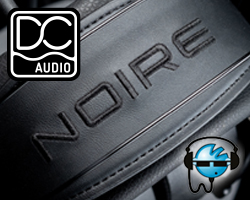
























































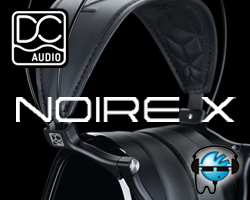

































































You must be logged in to leave a reply.